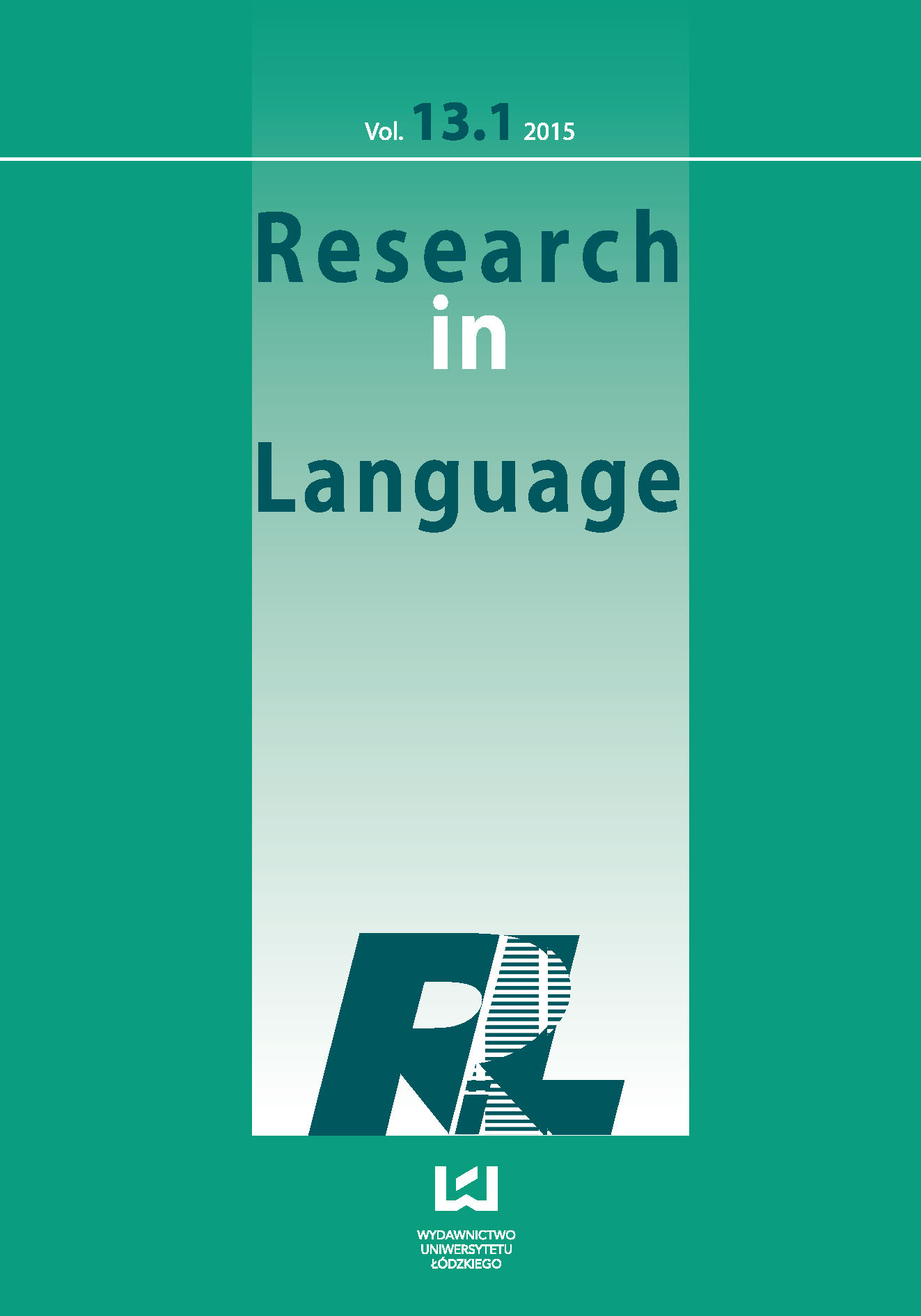Changes in Received Pronunciation: Diachronic Case Studies
DOI:
https://doi.org/10.1515/rela-2015-0010Keywords:
-Abstract
This paper sets out to investigate changes and individual irregularities in the Received Pronunciation of a number of individuals over time and to compare them with the changes noted in contemporary RP in the literature. The aim of the study is to ascertain whether accent change affects individuals during their lifetimes or is only brought about by new generations of speakers accepting different pronunciations as the norm and effectively speaking with a different accent to older generations within their social circle. The variations/changes looked for were: CLOTH transfer, CURE lowering, GOAT allophony, R-sandhi, and T-voicing. The procedure of the study was to identify the presence or absence of these features in the speech of certain individuals in recordings made over a period of at least 35 years. The individuals studied were: Her Majesty Queen Elizabeth II, Baroness Thatcher, Sir David Attenborough and David Dimbleby. The results of these comparisons suggest that individual speakers are not greatly affected by changes in pronunciation taking place around them and generally stay with the preferred pronunciation of their youth. There are, however, cases where a general uncertainty amongst speakers of the accent, here found in CURE lowering, does influence the speech of individuals over time.
References
Bowie, D., & Yaeger-Dror, M. (2014). Phonological change in real time. In P. Honeybone & J. Salmons (Eds.), The Oxford Handbook of Historical Phonology (chapter 34). Oxford: Oxford University Press.
Google Scholar
British Library. Received Pronunciation. http://www.bl.uk/learning/langlit/sounds/casestudies/received-pronunciation/.
Google Scholar
Connor, S. (2000). Cor blimey! Even the Queen no longer speaks the Queen’s English. The Independent, 21st December, 2000.
Google Scholar
Cruttenden, A. (2001). Gimson’s Pronunciation of English (6th ed.). London: Arnold.
Google Scholar
Evans, B. G., & Iverson, P. (2007). Plasticity in vowel perception and production: A study of accent change in young adults. Journal of the Accoustical Society of America, 121(6), 3814-3826.
Google Scholar
Foulkes, P. (1997). English [r]-sandhi - a sociolinguistic perspective. Histoire Épistémologie Langage. Tome 19, fascicule 1, 1997. Construction des théories du son [Première partie], 73-96.
Google Scholar
Gimson, A. C. (1980). An introduction to the pronunciation of English (3rd ed.). London: Edward Arnold.
Google Scholar
Hannisdal, B. R. (2006). Variability and change in Received Pronunciation. Bergen: University of Bergen.
Google Scholar
Harrington, J. (2006). An acoustic analysis of ‘happy-tensing’ in the Queen’s Christmas broadcasts. Journal of the International Phonetic Association, 34, 439-457.
Google Scholar
Harrington, J. (2007). Evidence for a relationship between synchronic variability and diachronic change in the Queen’s annual Christmas broadcasts. In J. Cole & J. Hualde (Eds.), Laboratory Phonology 9 (pp 125-143). Mouton de Gruyter:Berlin.
Google Scholar
Harrington, J., Palethorpe, S., & Watson, C. (2000a). Vowel change in received Pronunciation: Evidence from the Queen’s English. 8th Aust.Int.Conf.Speech Sci. & Tech, 130-135.
Google Scholar
Harrington, J., Palethorpe, S., & Watson, C. (2000b). Does the Queen speak the Queen’s English? Nature Vol. 408, 927.
Google Scholar
Harrington, J., Palethorpe, S., & Watson, C. (2000c). Monophthongal vowel changes in received Pronunciation: an acoustic analysis of the Queen’s Christmas broadcasts. Journal of the International Phonetic Association. 30(1/2), 63-78.
Google Scholar
Honey, J. (1985). Acrolect and hyperlect: the redefinition of English RP. English Studies 66(3), 241-257.
Google Scholar
International Phonetic Association. (1999). Handbook of the International Phonetic Association. Cambridge: Cambridge University Press.
Google Scholar
Ježek, M. (2012). The double-edged sword of RP: the contrasting roles of a pronunciation model in both native and non-native environments. Research in Language, vol. 10.2, 133-142. DOI: 10.2478/v10015-011-0037-6
Google Scholar
Jones, D. (1917). An English pronouncing dictionary. London: J. M. Dent & Sons.
Google Scholar
Kerswill, P. (2006). RP, Standard English and the standard/non-standard relationship. In D. Britain (Ed.), Language in the British Isles (2nd ed.), (pp 1-18). Cambridge: Cambridge University Press.
Google Scholar
MacMahon, M. K. C. (1998). Phonology. In S. Romaine (Ed.), The Cambridge History of the English Language. Vol. 4: 1776-1997 (pp. 373-535). Cambridge: Cambridge University Press.
Google Scholar
Nevalainen, T. (2003). English. In A. Deumert & W.Vandenbussche (Eds.), Germanic standardizations: past to present (127-156). Amsterdam: John Benjamins.
Google Scholar
Piotrowski, M. (2011). Queen’s English - Is Queen Elizabeth II becoming non-standard? Gavagai Journal 1, 28-38.
Google Scholar
Sankoff, G. (2005). Cross-Sectional and Longitudinal Studies in Sociolinguistics. In U. Ammon, N. Dittmar, K. J. Mattheier, & P. Trudgill (Eds.), An International Handbook of the Science of Language and Society, vol. 2 (pp. 1003-13), Berlin: Mouton de Gruyter.
Google Scholar
Sankoff, G., & Blondeau, H. (2007). Language Change Across the Lifespan: /r/ in Montreal French. Language 83, 560-88.
Google Scholar
Trudgill, P. (2008).The historical sociolinguistics of elite accent change: On why RP is not disappearing. Studia Anglica Posnaniensia 44, 3-12.
Google Scholar
Upton C. (2008). Received Pronunciation. In C. Upton & B. Kortmann (Eds.), Varieties of English: The British Isles (pp 237-52). New York: Mouton de Gruyter.
Google Scholar
Wells, J. C. (1982). Accents of English (3 vols.). Cambridge: Cambridge University Press.
Google Scholar
Wells, J. C. (1997). Whatever happened to Received Pronunciation? In C. C. Medina & P. Soto (Eds.), Il Jornadas de Estudios Ingleses (pp. 19-28). Universidad de Jaén, Spain.
Google Scholar
Wells, J. C. (1999). Which pronunciation do you prefer? IATEFL Issues 149, 10-11.
Google Scholar










